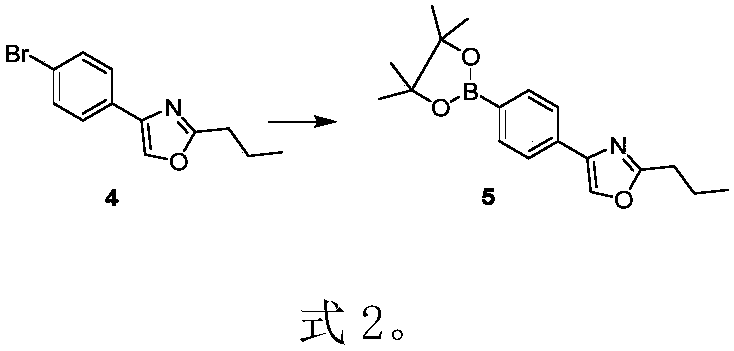Preparation method of pusaimode (Chinese name)
A synthesis method and intermediate technology, applied in the field of medicine, can solve the problems of low yield, long synthesis route, large environmental pollution and the like
- Summary
- Abstract
- Description
- Claims
- Application Information
AI Technical Summary
Problems solved by technology
Method used
Image
Examples
preparation example Construction
[0016] The technical solution for realizing the purpose of the present invention is to provide a new preparation method of Prosamod, and the synthesis steps are as follows: the preparation route of the key intermediate 5 is shown in formula 3, starting from bromobenzene, the first step is to pass the bromobenzene through the tocoyl group In the second step, compound 2 is esterified with butyrate to generate compound 3, and in the third step, compound 3 is cyclized with butanamide to generate compound 4. In the fourth step reaction, compound 4 is coupled with bis-pinacol borate under the catalysis of palladium catalyst to generate compound 5.
[0017]
[0018] a. Dissolve bromobenzene (compound 1) and chloroacetyl chloride in anhydrous dichloromethane, add anhydrous aluminum oxide in batches under ice bath, and the reaction is completed in about 0.5-3 hours. The reaction solution was poured into a 1mol / L hydrochloric acid mixed solution of ice and water. Extraction, drying ...
preparation example 1
[0043] 2-Propyl-4-(4-(4,4,5,5-tetramethyl-1,3,2-dioxaborolan-2-yl)phenyl)oxazole (compound 5) Synthesis
[0044]
[0045] a. Synthesis of 1-(4-bromophenyl)-2-chloro-1-one (compound 2): 20.0g of bromobenzene was dissolved in dichloromethane (200mL) solution, placed in a three-necked flask for external cooling With stirring, 10.6 mL of chloroacetyl chloride was dissolved in dichloromethane (50 mL), and slowly dropped into the three-necked flask. Keeping the temperature low, 20.4g of anhydrous aluminum chloride was added into the reaction flask in three batches (7.0g was added for the first time, 7.0g was added for the second time, and 6.4g was added for the third time). After 1 hour, the reaction was basically completed, and the reaction solution was poured into 250 mL of dilute hydrochloric acid-ice-water mixture and stirred for half an hour until the reaction turned light yellow-green. Use dichloromethane to extract and separate (200mL×3), wash with saturated brine (200mL×...
preparation example 2
[0050]
[0051] Synthesis of 2-acetylamino-2-(4-bromophenethyl)diethyl malonate (key intermediate 6):
[0052] a. Synthesis of 1-bromo-4-(2-iodoethyl)benzene (compound 11): 31.6 g of iodine, 33.9 g of triphenylphosphine and 22.4 mg of imidazole were dissolved in anhydrous dichloromethane (100 mL), After cooling in an ice bath for 30 minutes, 20.0 g of p-bromophenylethanol was dissolved in anhydrous dichloromethane (50 mL), and quickly added dropwise into the reaction flask. The ice bath was removed, and the reaction was carried out at room temperature for about 6 hours. Evaporate dichloromethane, add water-methanol mixed solution (400mL, water:methanol volume ratio is 1:3), transfer to a separatory funnel, add n-heptane for extraction (200mL×3), shake vigorously until the whole system is free The color is transparent, and the organic layers are combined. Dry over anhydrous sodium sulfate, distill off the organic solvent to obtain a colorless transparent solid, which is co...
PUM
 Login to View More
Login to View More Abstract
Description
Claims
Application Information
 Login to View More
Login to View More - R&D
- Intellectual Property
- Life Sciences
- Materials
- Tech Scout
- Unparalleled Data Quality
- Higher Quality Content
- 60% Fewer Hallucinations
Browse by: Latest US Patents, China's latest patents, Technical Efficacy Thesaurus, Application Domain, Technology Topic, Popular Technical Reports.
© 2025 PatSnap. All rights reserved.Legal|Privacy policy|Modern Slavery Act Transparency Statement|Sitemap|About US| Contact US: help@patsnap.com



